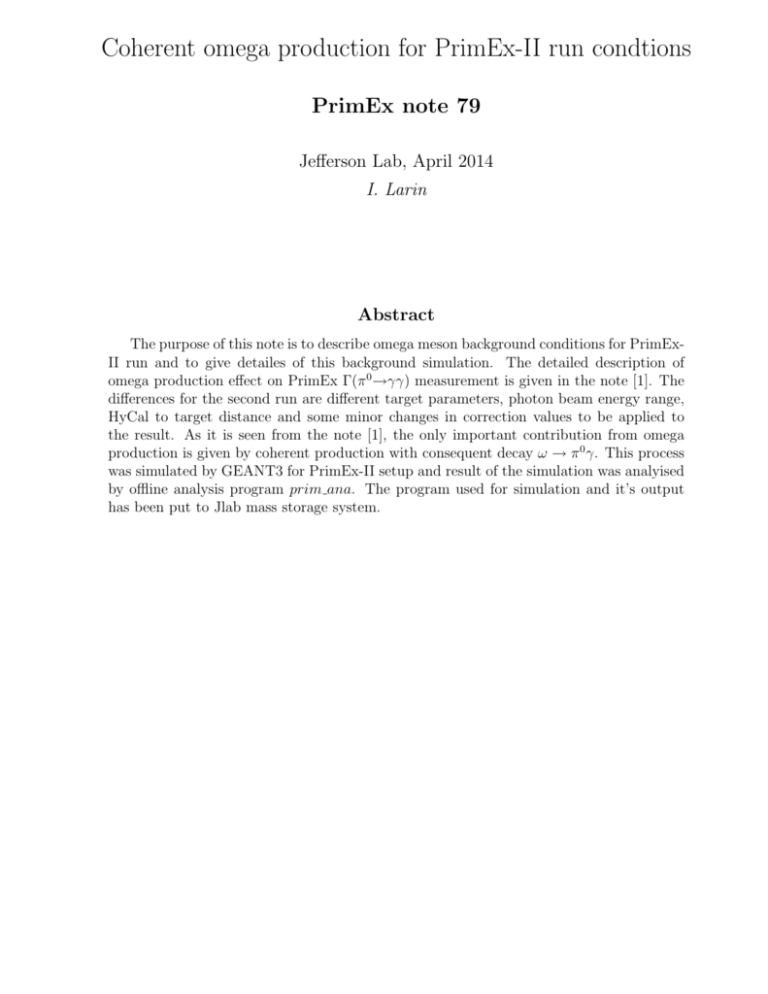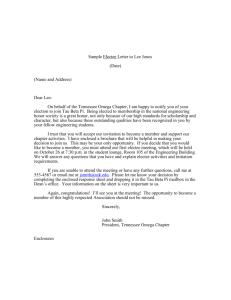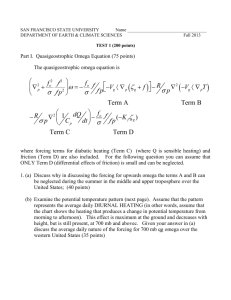Coherent omega production for PrimEx-II run condtions
advertisement

Coherent omega production for PrimEx-II run condtions PrimEx note 79 Jefferson Lab, April 2014 I. Larin Abstract The purpose of this note is to describe omega meson background conditions for PrimExII run and to give detailes of this background simulation. The detailed description of omega production effect on PrimEx Γ(π 0 →γγ) measurement is given in the note [1]. The differences for the second run are different target parameters, photon beam energy range, HyCal to target distance and some minor changes in correction values to be applied to the result. As it is seen from the note [1], the only important contribution from omega production is given by coherent production with consequent decay ω → π 0 γ. This process was simulated by GEANT3 for PrimEx-II setup and result of the simulation was analyised by offline analysis program prim ana. The program used for simulation and it’s output has been put to Jlab mass storage system. 1 Coherent omega production cross section Coherent omega production total and differential cross sections were calculated as described in [1]. For nuclear density function ρ(r) we used Woods-Saxon parameterization: 2 1 + w Rr 2 ρ(r) = ρ0 1 + exp( r−R ) c (1) R∞ where ρ0 - normalization term ( 4πr2 ρ(r)dr = 1). Parameter values were taken from [2]: 0 For 12 C (Z=6, A=12): w = -0.149(5); R=2.355(4) fm; c = 0.5224(20) fm; ρ0 = 0.01519 fm−3 . For 12 Si (Z=14, A=28): w = -0.233(9); R=3.340(9) fm; c = 0.580(3) fm; ρ0 = 0.00646984 fm−3 . P For target A2 in cross section formula (1), note [1] we used wi A2i , were sum is taken over main isotops, and wi is ith isotop abundance. Calculations for PrimEx-II flux distribution other E-channels and their energy values (first 18 T-counters only were included) gave us 12.6 µbarn for Carbon and 29.09 µbarn for Silicon (keep in mind that the precision with what these values are known experimentaly is 20%). 2 Simulation result for omega background About 50M Monte-Carlo events has been simulated for silicon and carbon target each (exact number of events was slightly increased, so after beam absorption in target it was exactly 50M omega production events). It’s taken about 200 days total CPU time on Jlab farm. To compare simulation result with the data one needs to apply scale factor for simulated events which couild be calculated as a ratio of photon beam flux used in F luxdata analysis to the equivalent ”Monte-Carlo flux”: k = F lux . Calculated ”Monte-Carlo equiv.M C flux” according to the formula (8) note [1] for the whole simulated data set (50M events) is: 428.3·1012 for Silicon and 274.6·1012 for Carbon. For parameters in the formula (8) note [1] we used: Br = Br(ω → π 0 γ) × Br(π 0 → γγ) = 0.0828 × 0.98823 = 0.081825, <ε> = 0.995(HyCal resp. f unc.) × 0.995(ADC err.) × 0.987(accidentals)× ×0.98(best in time beam) × 0.99(V ET O) × 13./12.(add ρ0 ) = 1.027, <σ> = 29.1 µbarn (Si), 12.64 µbarn (C), Ltgt atoms = 0.04973456 barn−1 (Si), 0.1770091 barn−1 (C), Ngenerated M C = 52.06M (Si), 51.6M (C). For the simulation we used Run 64970 for silicon and 65030 for carbon. For geometry and ADC gains/lineraity we used current tables from cal db: system = crystal or glass, attributes: alignment, pi0 gain isl, nonlin en1, nonlin en2, etc. In case if these tables will be updated, one have to take care to use the same tables as were used for the simulation. For example it is possible to copy that tables into corresponding Monte-Carlo tables and used them in prim ana. For silicon runs HyCal ADC status for all channels was averaged on all different tables, which were used. Average ADC status for all silicon runs was simulated by random usage of different runs weighted with photon flux: 2 (Run=64710, weight=0.3136459), (Run=64781, weight=0.0464973), (Run=64811, weight=0.0154286), (Run=64845, weight=0.0744261), (Run=64866, weight=0.1377264), (Run=64905, weight=0.4122757). 3 Output Output of Monte Carlo has been uploaded to Jlab mass storage system in directories” /mss/hallb/primex2/mcdata/omega/si and /mss/hallb/primex2/mcdata/omega/c12. The Monte Carlo and generator program used to generate ω production has been tarred and copied to file: /mss/hallb/primex2/mcdata/omega/mc and gen.tar.gz Monte Carlo files extentions are: .txt for program standard output, .tit for GEANT title file used, .out for ”PrimEx-I stryle” unformatted fortran output, .cout for new C binary style output, .hbk for histogram PAW files. Merged .hbk files are also available. The most important statistics histograms one may need to look are: 600 (first bin - number of beam photons generated, second bin - number of beam photons produced ω, i.e. not absorbed in the target before pregenerated interaction piont); 611 - generated beam flux distribution on T-counters, 612 - generated beam flux distribution on E-channels. References [1] I.Larin, A.Gasparian, L.Gan, S.Gevorkyan, ”The π 0 background from ω and ρ mesons photoproduction in PRIMEX ”, PrimEx Note 51, (2007) http://www.jlab.org/primex/primex notes/omega note.pdf [2] H. De Vries, C. W. De Jager and C. De Vries, ”Nuclear charge and magnetization density distribution parameters from elastic electron scattering” Atom. Data Nucl. Data Tabl. 36, 495 (1987). 3




